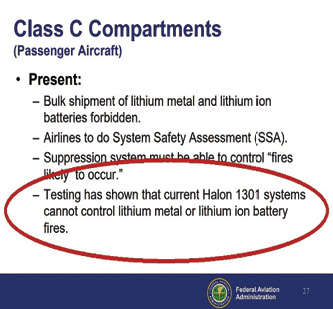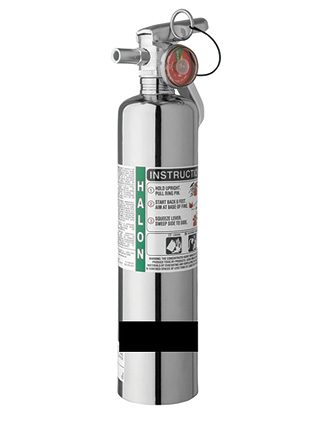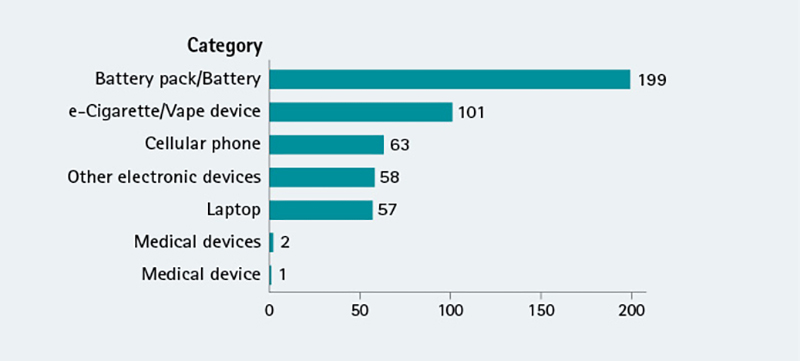Energy Fires | By CHRIS G. GREENE
The airline industry provides one of the safest travel environments available. Despite the frustrations of getting to and from the airport, once onboard that plane, our travel experience is pleasant and unremarkable.
- EV Charging Stations and the E-Stop Dilemma
- Lithium-Ion Batteries: The 18650
- The Lithium-Ion Revolution
Because of this predictability, it is easy to become comfortable with flying. As passengers, we take for granted the level of investment this industry has made to ensure our comfort and safety. In 2023, the airline industry will likely surpass 35 million flights. That’s more than 45,000 flights per day, and virtually all of them will be safe and uneventful. So, when there is a problem with any of these flights, there is an immediate reverberation throughout the industry.
Fires on airplanes are extremely rare. When they do occur, the event is salient. For airline personnel, the training and expectations are clear—aggressively pursue extinguishment of the fire and land the plane with urgency. Historically, fires on planes have primarily been the result of a mechanical or electrical problem with the aircraft itself or one of the engines. These incidents have resulted in changes to design and tighter inspection procedures. The facts are simple: Despite the massive engineering footprint and experience that goes into designing a modern aircraft, sometimes time in the sky reveals a problem. And, on the rarest of incidents, such a problem results in fire or loss of an aircraft. This is something the industry owns with sobering transparency. However, there is a new concern for this industry, one that is not owned singularly by it but one for which the traveler must assume some responsibility.
Thermal events on airplanes have been increasing over the past 10 years, and the cause is clear. The failure of portable rechargeable devices powered by lithium-ion batteries—i.e., phones, laptops, e-cigarettes, and so on—has resulted in nearly 500 thermal events on planes since 2006 (Figure 1). This rapid increase is concerning and reflects the public’s ubiquitous dependence on these batteries. However, bringing a laptop or e-cigarette onboard an aircraft isn’t really a choice, is it? When these devices fail inflight, they create a nightmare for the airline industry.
Figure 1. Lithium-Ion Battery Events That Resulted in Smoke, Fire, or Extreme Heat

These events are what is known and tracked by the FAA. However, this information should not be considered a complete listing of all such events on aircraft.
Source: Federal Aviation Administration.
Fire on a Plane at Altitude
Engineering a safety system for this situation is nearly impossible. As the battery industry has discovered, designing a lithium-ion cell that is 100% impervious to thermal failure seems like an insurmountable challenge. The airline industry did not create this problem, but it is very much saddled with its resolution. It’s a tall order and we, as travelers, need to start assuming some of this responsibility.
For an airline pilot, there will be one basic question: “Is the fire in the cargo area or passenger compartment?” If the event occurs in the cargo area, it will likely trigger a smoke detector activation. Unfortunately, for nearly every passenger plane in the sky, there is no way to actively pursue this problem. Despite what you may have seen in the movies, accessing the cargo area from the passenger compartment is not going to happen, and there is no guarantee of having a fixed extinguishing system in the cargo area of a passenger plane. At best, if the plane is expected to go over large bodies of water, there will be a Halon 1301 suppression system to cover the cargo compartment.
For most incidents involving fire in the cargo area, the safety of the travelers and crew will completely depend on rapid discovery of the problem by the smoke detector system and the fire containment features that have been engineered for that space. As a passenger on this plane, you can expect a controlled but urgent descent to get that plane on the ground. A document published by the Civil Aviation Authority (CAA) implies that with an uncontrolled fire on a plane, the pilot has less than 19 minutes before the cabin area becomes untenable.
For example, in July 2011, the crew of a Boeing 747 cargo plane carrying a shipment of electronics and lithium-ion car batteries reported a fire onboard the plane. Eighteen minutes later, contact with the aircraft was lost, and it plunged into the Strait of Korea. In 2016, as a response to the growing number of fire events, the CAA banned both lithium metal and lithium-ion cell batteries from the cargo areas of passenger planes. For cargo aircraft shipping lithium-ion batteries and devices, the state of charge (SOC) of the batteries must be below 30%; this reflects a clear understanding of how an elevated SOC can affect burn characteristics of lithium-ion batteries. With few exceptions to this rule, the industry has seen a marked decrease in the number of battery fires originating from the cargo area since this regulation was put in place.
When a fire occurs in the passenger compartment of an aircraft, there is a multitude of intervention options available, with two overriding objectives: actively and aggressively attempt to extinguish the fire and, for the pilots, land the plane in earnest. Flight crews receive robust training on actions to take in the unlikely event of a fire; because of the recent increase in battery-fire events, they are drawing on this training with greater frequency.
Planes are outfitted with portable fire extinguishers for use by the crews; both water-based and Halon 1211 extinguishers will likely be available onboard. These portable extinguishers will be the tool crews will reach for and, although either type will likely address a small content fire isolated to one or two carry-on bags, they will not extinguish the fire from the lithium-ion cell itself. We, the fire service, have learned this the hard way. The airline industry is also aware of this challenge (Figure 2). The combination of portable extinguishers and nonalcoholic liquids will be the best fire-quenching option.
For a fire that occurs in a carry-on bag, the extinguisher will be effective for the initial knockdown, but the contents will need to be thoroughly soaked to ensure complete extinguishment. Reducing the fire potential footprint is key to buying the pilots time to land the plane. Given the number of events on passenger planes over the past 10 years, and the fact that we have not lost a single aircraft, the data suggests that our flight crews have performed admirably in these situations.
Halon Fire Suppression Agents
Halon was developed by the U.S. Army and DuPont in 1954 to address sensitive equipment that would be found on an aircraft. Halon is a nonconductive and noncorrosive and, in small amounts, is considered nontoxic to humans. Halon 1301 (bromotrifluoromethane) may be used as part of a total flooding system for the cargo area of a plane. Halon requires less than an 8% concentration of agent by volume to extinguish a fire, leaving plenty of clean air available to use in the evacuation process. For comparison, although CO2 is also considered a nontoxic/nonconductive/nondirectional agent, CO2 concentrations of 34% or greater will be needed to extinguish a fire. Also, unlike CO2, there is no danger of cold shock to avionics or other sensitive electrical equipment. Halon 1211 (bromochlorodifluoromethane) is specific for portable fire extinguishers (photo 1). Unfortunately, Halon agents contain bromine and are considered ozone-depletion chemicals.
Figure 2. Class C Compartment Fires

The FAA is aware of the limitations of halon when attempting to quench a lithium-ion battery fire.


(1) Photos by author.
On January 1, 1994, the production and import of halons and halon agents were phased out in the United States. Today, the limited supply of halon agents is sourced from recycling processes for use in specialty applications such as aircraft suppression systems.
Fire Containment Bags
Fire containment bags (photo 2) were designed to contain fire from a portable handheld device like a tablet or cell phone. They have been used at several fire events on planes with good success. Although most airlines do carry them, the Federal Aviation Administration (FAA) has yet to require them on all passenger planes.
Specifically, the FAA does not object to the use of these containment products provided the procedures follow best practices laid out in SAFO 09013, AC 20-42D, and AC 120-80A. However, the FAA does not endorse any manufacturer procedure that suggests moving a burning, smoking, or hot device. I have personally seen these containment bags on flights as well as the accompanying thermal gloves donned by crew members who use this resource. Requiring these devices on all passenger planes would be prudent.
How the Traveler Can Help
Familiarize yourself with the FAA regulations for travel. Specifically, do not allow your portable rechargeable devices to be checked in the cargo area. When traveling with additional batteries and devices, ensure they are in good working order. If that device has been getting warm when you charge it, will not accept a complete charge, or seems to be swelling—something you may only notice when you clip in the battery pack and it sticks—it should not be brought onto any aircraft. If you have additional devices for transport, ensure they are completely powered off before you board. As a passenger, you should never transport damaged, defective, or recalled lithium-ion batteries or devices. E-cigarettes play a particularly problematic role here and must never enter the cargo space (Figure 3).
Figure 3. Lithium-Ion Battery Incidents, 2013-2023

E-cigarettes are responsible for a large percentage of battery fires and are categorically banned from the cargo area of a passenger aircraft. Source: Federal Aviation Administration.
How the Airline Industry Can Improve
The airline industry should provide better clarity on what is and is not allowed to be stowed in the cargo area of the plane. For example, most airline check-in apps have prompts that ask passengers to confirm they are not carrying “lithium batteries” in their checked bags. This is problematic for two reasons. First, lithium batteries are not the problem—lithium-ion batteries are. For people who understand this issue, it is confusing and misleading. Second, these days, most lithium-ion batteries are part of a device.
The public’s experience is that we never actually see the cells/batteries. We’re not swapping out the batteries like we do with a traditional nonrechargeable format battery—i.e., AA or AAA alkaline—we just plug in the device and allow it to charge. If the intent is to keep lithium-ion batteries out of a passenger plane’s cargo area, then the language should identify all portable rechargeable devices. Lithium-ion batteries are generally part of the device itself, so identify them as such.
Where We Are Heading
Figure 1 clearly shows that thermal incidents involving lithium-ion devices on aircraft are on the rise. Of particular concern is the sharp inflection point in 2016. Since then, the number of fires on passenger planes has increased dramatically and shows no signs of slowing. Additionally, the chart identifies a total of 433 FAA verified thermal events between 2006 and 2022, with nearly 80% of them occurring within the past seven years. Furthermore, this chart does not account for the 54 events that have occurred thus far in 2023.
I believe in the care the airline industry takes to ensure the safety of travel. However, I grow concerned when I hear pilots tell me that one of their deepest trepidations is having all these batteries on our planes, particularly when we travel over water. A water landing in the Pacific Ocean is simply not going to end well. We all must assume some responsibility for the safety of the aircraft. The industry has done its part, and we must do ours.
Reference
1. skybrary.aero/sites/default/files/bookshelf/210.pdf.
CHRIS G. GREENE is a captain (ret.) with the Seattle (WA) Fire Department and the supervising officer for its Energy Response Team and Program.

